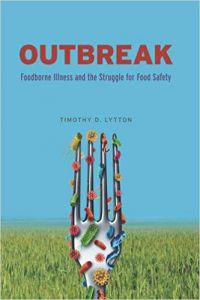
 I’m reading an excellent new book by Timothy Lytton covering the history of famous food-borne illnesses and how they led to major changes in the rules and legislation around food safety. It’s well written and gives a detailed account to the events and subsequent actions that shape the industry today.
I’m reading an excellent new book by Timothy Lytton covering the history of famous food-borne illnesses and how they led to major changes in the rules and legislation around food safety. It’s well written and gives a detailed account to the events and subsequent actions that shape the industry today.
It got me thinking about how complex the whole process is. Not just the identification of an outbreak and the detective work in tracking down a source, but also the complexity around the lessons to be learned and how these may eventually be incorporated into rules and legislation. This sometimes happens with great resistance from the industry, and sometimes with considerable support from those most impacted.
Consider the spinach crisis of 2006. This was a tragic event that resulted in more than a hundred people requiring hospitalization and, sadly, three deaths. The spinach industry was wiped out for the remainder of 2006 with a significant follow-on impact the following year. In this case there was a powerful and dramatic response from the growers that led to improved agricultural practices. It led to the creation of the California Leafy Greens Products Handler Marketing Agreement which was a key input to the Produce Rule of the Food Safety Modernization Act (FSMA). Growers were determined to limit the damage from a future event. It’s simple to say that the spinach outbreak led to key provisions in FSMA, but the story is not that straightforward.
It took years (2006 – 2015), and hundreds of meetings of various groups to create all the organizations and documents that were published and revised before there was a comprehensive, science-based agreement. Thankfully, most of the industry did not wait for the final version and instead implemented major changes as the rules evolved.
The key difference between the loose recommendations that were in place before 2006 and the Produce Rule is science-based specificity. The old rules used terms like “growers may…,” versus “growers must…,” and guidelines often failed to give details such as frequency of water testing or requirements for training or audits.
 Another outbreak, covered at length in the book, is the listeria melon outbreak centered on Jensen Farms. Each outbreak yielded many lessons. There was outrage after it was discovered that Jensen Farms had been given a 96% superior rating by an outside audit firm. If you got 96% on a test you’d be pretty happy, right? However, over the years the audit processes used by numerous organizations had evolved to be misleading and even ludicrous. The report giving the 96% rating included right on page one an alert to practices that were considered inadequate and could lead to an outbreak. I suspect that few people read the report past the 96% rating. The exact cause has never been categorically identified although there are some smoking guns including an organic fertilizer and poorly installed and maintained equipment.
Another outbreak, covered at length in the book, is the listeria melon outbreak centered on Jensen Farms. Each outbreak yielded many lessons. There was outrage after it was discovered that Jensen Farms had been given a 96% superior rating by an outside audit firm. If you got 96% on a test you’d be pretty happy, right? However, over the years the audit processes used by numerous organizations had evolved to be misleading and even ludicrous. The report giving the 96% rating included right on page one an alert to practices that were considered inadequate and could lead to an outbreak. I suspect that few people read the report past the 96% rating. The exact cause has never been categorically identified although there are some smoking guns including an organic fertilizer and poorly installed and maintained equipment.
As a result, audit processes have been tightened up and the shift in emphasis to proving you’re doing the right things right has led to even better food safety practices.
As consumers, we generally assume the food we buy is safe to eat. Behind the scenes, making it so, involves an army of people constantly learning, be it from improved science or from audits or, unfortunately, from actual outbreaks. Thankfully, we are far from the days when the industry actively lobbied against improvements such as during the clean milk problems of the late 1800’s and early 1900 or the botulism outbreak in canned soup in the early 1970s.
But those are other fascinating stories you’ll have to read for yourself.
Lorem ipsum dolor sit amet, consectetur adipiscing elit

These Stories on Food Safety
Procurant USA LLC
180 Westridge Drive - Suite 100
Watsonville, CA 95076
1-669-221-1026
info@procurant.com

Procurant is transforming the global food supply chain with technology to reduce waste, increase visibility, improve food safety and digitize business from production to consumption. The company was founded by industry veterans with decades of experience delivering solutions to growers, shippers, distributors, retailers and foodservice operators.